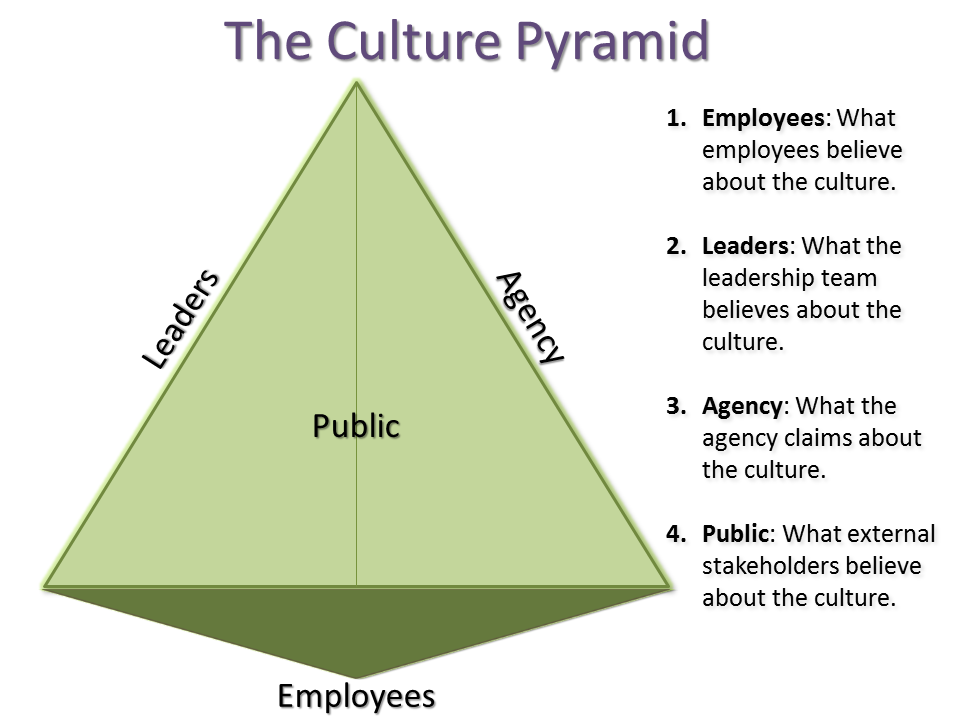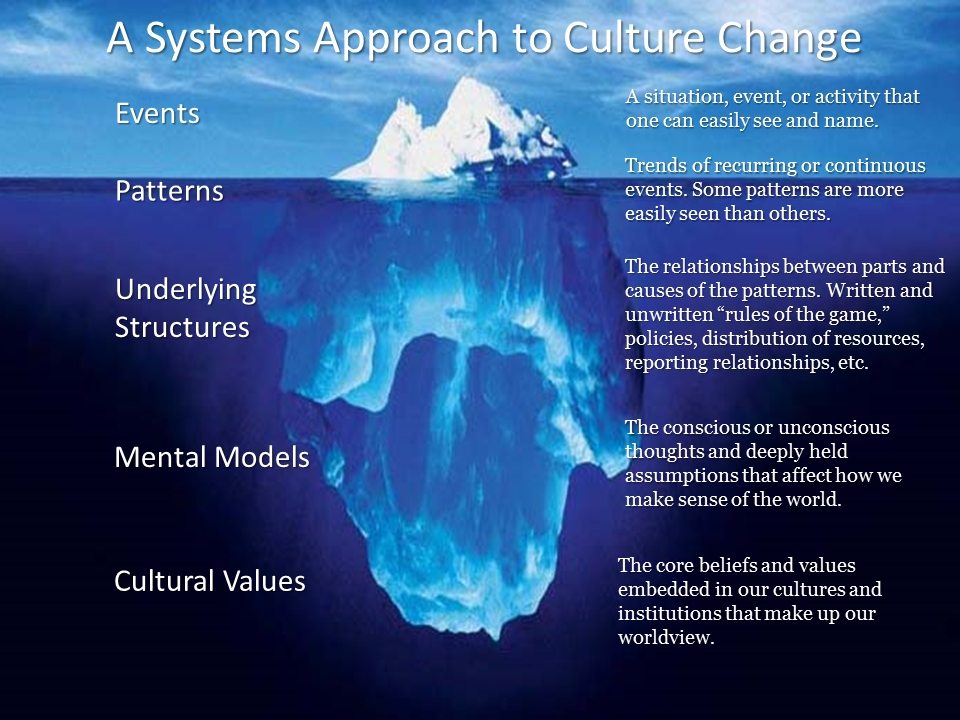![]()
The verdict is in. We are living in an age of disruption; an information revolution, which most economists agree is as profound and disruptive as the agricultural and industrial revolutions. In his new book Thank you for Being Late Thomas Friedman refers to this as an “age of accelerations” in which markets, Mother Nature, and technology are all undergoing simultaneous, exponential acceleration, leading to massive disruption and dislocation. We withstand this disruption and dislocation by building resilience.
For government agencies, becoming more resilient means taking a hard look at our agency culture. We are already beginning to see significant effects of rapid change within our political and government institutions. Do we have robust, resilient agency cultures in place that can cope with disruptive challenges in the future?
The Culture pyramid
Defining organizational culture is simple: culture is the way our organizations think and act. Every organization has one, and it can make the difference between mission accomplishment, and abject failure. Culture is expressed by different people in different ways; to help visualize this, imagine your agency culture as a three dimensional triangle or pyramid.

Employees:
Agency employees comprise cultural realities. Yet what employees believe may be completely different from the perspectives of leadership and agency communications.
Leadership:
As a leader in your organization, you must have a clear view of the realities of the culture. Ask advisers, mentors, employees, coaches, and fellow leaders for feedback.
Agency:
Every agency makes statements about their mission and culture. However, is it accurate? Be sure it is not too far removed from reality. By proclaiming one thing and permitting another, we may inadvertently foster the belief that our agency communications cannot be trusted.
Public:
Different members of the public will have different perspectives regarding the culture of our agency. In the information era, these perspectives are largely fed by what employees and consumers say and share online.
According to servant leadership guru Ben Lichtenwalner, in the previous century “strong leaders and agencies (sides 2 and 3) could mask the reality in sides 1 and 4 (employees and the public.)” However, due to technological disruption, this is no longer true. The internet and social media now communicate instantaneous employee and public perceptions that are far stronger and carry much greater weight than leadership and agency statements. If there perceptions are overwhelmingly negative, they can infect and erode our organizations from the inside out. If we do not intentionally prioritize the management of our culture, it will manage us.
The Dangers of a Potemkin Culture
Does the true culture of your agency match that communicated by senior leadership? On a 1787 trip to survey new Russian conquests in Crimea, Empress Catherine II “the Great” was greatly impressed by the succession of bustling, thriving towns she encountered along the river she sailed. It was only later revealed that General Grigory Potemkin, the Governor of the region, had systematically ordered each town built the night before her arrival, ordered his men to dress and function as the peasant population during her visit, and then deconstruct the town after her departure, only to reassemble it further down the river.

Does a fresh coat of paint mask the true state of your agency’s culture?
In truth, this area of Crimea was a relatively barren wasteland, yet Catherine concluded her trip with an entirely different belief. Like many such stories, the details may have been inflated for dramatic effect over the years, but it illustrates a key point: Do your agency’s senior leaders see the culture as it truly exists, or do they see only what you want them to see? In our efforts to prove our worth, show our accomplishments, and build our resumes & reputations, are we honest with our leaders when such honesty may reveal potential shortcomings? If we consistently paint a rosy picture for senior leaders, can we fairly criticize them when they don’t fully understand the nature of the problems that exist in the field? Before we can embark on a culture change effort, we must fully visualize our culture and ensure that we have a common, shared understanding of where we are, and where we are going before we all get on board.
Visible and Invisible Culture
When undertaking cultural change, most initiatives focus upon the tip of the iceberg. We are quick to highlight a certain “event” we see as emblematic of the current culture and throw time and money into quickly fixing it. Leaders order training programs, release memos, and attempt quick fixes that address the event. However, does the event itself truly represent the culture they seek to change? To truly effectuate a sustainable and long-lasting change, we must take a systems approach and look beneath the event at the underlying patterns, structures, and causes.

Culture is deeply rooted and can be exceedingly difficult to change. It takes all of us to create and sustain a culture, and it will take us all to change it as well. When undertaking a task as monumental as culture change, we must be strategic about where we target our intervention efforts; the deeper the level, the more seismic the shift.
If we are truly serious in our desire for change, we must start by convening a diverse team to collectively explore and define what, specifically, is taking place at each level of the system, how the layers are interconnected, and how they influence one another. Charles Kettering, the famed inventor and head of research for GM, once said “a problem well-stated is a problem half-solved.” Without a thorough understanding of the current problem, not only will it be impossible to measure our progress, but it will be exceedingly difficult to build alignment around a desired end goal and result.
In next week’s post, I’ll continue to explore this topic by looking at some concrete steps that we may take to drive culture change.
Dylan Mroszczyk-McDonald is part of the GovLoop Featured Blogger program, where we feature blog posts by government voices from all across the country (and world!). To see more Featured Blogger posts, click here.





Leave a Reply
You must be logged in to post a comment.